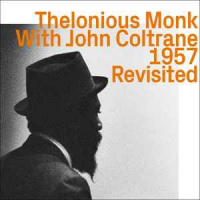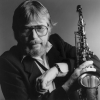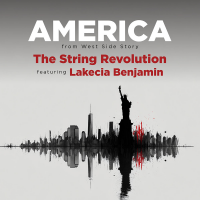Home » Jazz Musicians » Gigi Gryce
Gigi Gryce
Gigi Gryce was born George General Grice(sic) on 28th November, 1925 (not 1927) in Pensacola, Florida - although he was brought up in Hartford, Connecticut. He spent a short period in the Navy where he met musicians such as Clark Terry, Jimmy Nottingham and Willie Smith, who were to turn his thoughts from pursuing medicine to the possibility of making music for a living. In 1948 he began studying classical composition at the Boston Conservatory under Daniel Pinkham and Alan Hovhaness. It has been reported that he won a Fulbright scholarship and went to Paris to study under Nadia Boulanger and Arthur Honegger, although confirmation of this has been hard to establish. Although illness interrupted his studies abroad, the fruits of this immersion in classical modernism were the production of three symphonies, a ballet (The Dance of the Green Witches), a symphonic tone-poem (Gashiya-The Overwhelming Event) and chamber works, including various fugues and sonatas, piano works for two and four hands, and string quartets.
Gryce strictly separated his classical composing from his work in jazz and received inspiration and instruction from a number of 'unsung' jazz saxophonists. The first of these was alto player Ray Shep, also from Pensacola, who had played with Noble Sissle. Then there were three musicians Gryce had met whilst based in the Navy in North Carolina. Altoists, Andrew 'Goon' Gardner, who played with the Earl Hines Band and Harry Curtis, who performed with Cab Calloway, as did tenorman Julius Pogue, for whom Gryce reserved the highest accolade. As well as alto saxophone Gryce performed on tenor and baritone saxes, clarinet, flute and piccolo - a 1958 recording for the Metrojazz label saw him multitracking all these instruments over a conventionally- recorded rhythm section.
Whilst in Boston (from 1948) Gryce arranged for Sabby Lewis, and had working gigs with Howard McGhee and Thelonious Monk. When playing at the Symphony Hall he attracted the attention of Stan Getz who asked Gryce to arrange for him - Getz subsequently recorded three Gryce originals: Yvette, Wildwood and Mosquito Knees. Dissatisfied with these and other earlier compositions Gryce went on the Fulbright scholarship outlined previously. Returning to New York, Gryce arranged on record dates for Howard McGhee (Shabozz) and Max Roach (Glow Worm). In the summer of 1953 Gryce joined Tadd Dameron's band, and in the autumn of that year was with the Lionel Hampton band when they made their legendary European tour. Through Hampton's band Gryce met many musicians with which he was to collaborate with later, including Clifford Brown , Art Farmer, Quincy Jones and Benny Golson. Against Hampton's wishes this emerging nucleus of talent recorded a number of sessions in Paris for French Vogue in between Hampton gigs. There were many different permutations from quartets to a small big-band, interestingly labelled as an orchestra, alluding to Gryce's exploration of new orchestrations. Later that year Gryce married Eleanor Sears - they had three children together: Bashir, Laila and Lynette - before separating in 1964.
Read moreTags
Remembering Gigi Gryce

by Larry Slater
Saxophonist and composer Gigi Gryce was a fixture on the East Coast jazz scene in the 1950's and early 1960s, working with many of the giants of the era. A talented saxophonist known for his writing and arranging, he recorded with everyone from Clifford Brown and Donald Byrd to Art Blakey and Benny Golson. In the early '60s he quit the jazz scene and seemed to disappear, leaving many wondering as to his fate. Aside from his many ...
Continue ReadingThelonious Monk, John Coltrane: Thelonious Monk with John Coltrane 1957. Revisited.

by Stefano Merighi
Ci sono sodalizi artistici che segnano in maniera indelebile la ricchezza creativa dei protagonisti. Tra questi, di sicuro quello tra Thelonious Monk e John Coltrane, anno di grazia 1957. L'estroso pianista e compositore, ancora lontano dal ricevere i riconoscimenti meritati, trova finalmente qualcuno che interpreta le sue partiture con rara dialettica esecutiva: leggerezza e profondità, acume sottile e abbandono istintivo. L'apollineo sassofonista, all'epoca ancora turbato dalla tossicodipendenza, passa dalla frustrazione di un licenziamento da parte di ...
Continue ReadingThelonious Monk: With John Coltrane 1957 Revisited

by Chris May
Once again, the ezz-thetics label has taken some of the finest artefacts of mid-twentieth-century US jazz and sonically restored them, bringing an unprecedented level of clarity, precision and presence. It is no exaggeration to say that the Swiss-based label's work can be compared with the restoration of Michelangelo's frescoes on the ceiling of the Sistine Chapel during the 1980s, both in terms of the quality of the original material and the artistry with which the renovation has been executed. The ...
Continue ReadingGigi Gryce

by AAJ Staff
From the 1995-2003 archive: This article first appeared at All About Jazz in 2002. Gigi Gryce was a special kind of musician—the kind often overlooked by the mainstream jazz world today, but widely respected by those familiar with his all too brief time under the jazz spotlight of the 1950s. More often rated as a composer first, and an altoist second, his star burnt brightly in the later be-bop era that gave way to hard bop. Although he ...
Continue ReadingBackgrounder: Gigi Gryce's Nica's Tempo, 1955

Source:
JazzWax by Marc Myers
Gigi Gryce was one of jazz's most sensual arrangers. Like Billy Strayhorn, Tadd Dameron, Quincy Jones, Benny Golson and others, Gryce favored a cool sophistication in his compositions and arrangements. He was so exceptional as an orchestrator that it's easy to forget he was also a terrific alto saxophonist. One of Gryce's finest albums and a great entry point for those unfamiliar with him was Nica's Tempo. Recorded over multiple dates in 1955 for Savoy, Gryce liked arranging for little ...
read more
Jazz Musician of the Day: Gigi Gryce

Source:
Michael Ricci
All About Jazz is celebrating Gigi Gryce's birthday today!
Gigi Gryce was born George General Grice(sic) on 28th November, 1925 (not 1927) in Pensacola, Florida- although he was brought up in Hartford, Connecticut. He spent a short period in the Navy where he met musicians such as Clark Terry, Jimmy Nottingham and Willie Smith, who were to turn his thoughts from pursuing medicine to the possibility of making music for a living. In 1948 he began studying classical composition at ...
read more
Jazz Musician of the Day: Gigi Gryce

Source:
Michael Ricci
All About Jazz is celebrating Gigi Gryce's birthday today!
Gigi Gryce was born George General Grice(sic) on 28th November, 1925 (not 1927) in Pensacola, Florida- although he was brought up in Hartford, Connecticut. He spent a short period in the Navy where he met musicians such as Clark Terry, Jimmy Nottingham and Willie Smith, who were to turn his thoughts from pursuing medicine to the possibility of making music for a living. In 1948 he began studying classical composition at ...
read more
Jazz Musician of the Day: Gigi Gryce

Source:
Michael Ricci
All About Jazz is celebrating Gigi Gryce's birthday today!
Gigi Gryce was born George General Grice(sic) on 28th November, 1925 (not 1927) in Pensacola, Florida- although he was brought up in Hartford, Connecticut. He spent a short period in the Navy where he met musicians such as Clark Terry, Jimmy Nottingham and Willie Smith, who were to turn his thoughts from pursuing medicine to the possibility of making music for a living. In 1948 he began studying classical composition at ...
read more
Jazz Musician of the Day: Gigi Gryce

Source:
Michael Ricci
All About Jazz is celebrating Gigi Gryce's birthday today!
Gigi Gryce was born George General Grice(sic) on 28th November, 1925 (not 1927) in Pensacola, Florida- although he was brought up in Hartford, Connecticut. He spent a short period in the Navy where he met musicians such as Clark Terry, Jimmy Nottingham and Willie Smith, who were to turn his thoughts from pursuing medicine to the possibility of making music for a living... Read more.
Place our Musician of the Day ...
read more
Gigi Gryce: Jazz Lab

Source:
JazzWax by Marc Myers
The year 1957 was a bountiful one for Gigi Gryce. The alto saxophonist teamed with trumpeter Donald Byrd and formed the Jazz Lab, a group that allowed Gryce to record and perform his compositions and those by other artists with a particular feel and with varying tempos and moods. From February to September 1957, Gryce and Byrd recorded Jazz Lab albums for five different labels—Columbia, Riverside, Verve, Jubilee and RCA. Gryce, like Tadd Dameron, Quincy Jones, Benny Golson and Horace ...
read more
Jazz Musician of the Day: Gigi Gryce

Source:
Michael Ricci
All About Jazz is celebrating Gigi Gryce's birthday today!
Gigi Gryce was born George General Grice(sic) on 28th November, 1925 (not 1927) in Pensacola, Florida- although he was brought up in Hartford, Connecticut. He spent a short period in the Navy where he met musicians such as Clark Terry, Jimmy Nottingham and Willie Smith, who were to turn his thoughts from pursuing medicine to the possibility of making music for a living... Read more.
Place our Musician of the Day ...
read more
Jazz Musician of the Day: Gigi Gryce

Source:
Michael Ricci
All About Jazz is celebrating Gigi Gryce's birthday today!
Gigi Gryce was born George General Grice(sic) on 28th November, 1925 (not 1927) in Pensacola, Florida- although he was brought up in Hartford, Connecticut. He spent a short period in the Navy where he met musicians such as Clark Terry, Jimmy Nottingham and Willie Smith, who were to turn his thoughts from pursuing medicine to the possibility of making music for a living... Read more.
Place our Musician of the Day ...
read more
Jazz Musician of the Day: Gigi Gryce

Source:
Michael Ricci
All About Jazz is celebrating Gigi Gryce's birthday today!
Gigi Gryce was born George General Grice(sic) on 28th November, 1925 (not 1927) in Pensacola, Florida- although he was brought up in Hartford, Connecticut. He spent a short period in the Navy where he met musicians such as Clark Terry, Jimmy Nottingham and Willie Smith, who were to turn his thoughts from pursuing medicine to the possibility of making music for a living... Read more.
Place our Musician of the Day ...
read more
Jazz Musician of the Day: Gigi Gryce

Source:
Michael Ricci
All About Jazz is celebrating Gigi Gryce's birthday today! Gigi Gryce was born George General Grice(sic) on 28th November, 1925 (not 1927) in Pensacola, Florida - although he was brought up in Hartford, Connecticut. He spent a short period in the Navy where he met musicians such as Clark Terry, Jimmy Nottingham and Willie Smith, who were to turn his thoughts from pursuing medicine to the possibility of making music for a living... Read more. Place our Musician of the ...
read more














































